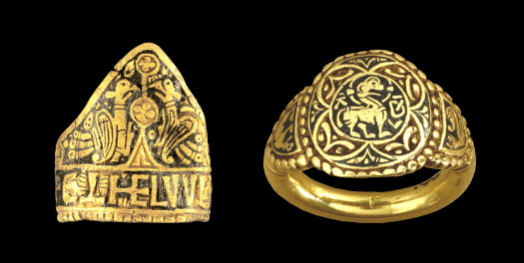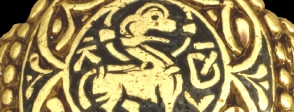
The rings
Both rings are decorated in a particular Anglo-Saxon style, with intertwined leaves and animals. The older and larger of the gold rings has a cross and a name: ‘Æthelwulf Rex’ – King Æthelwulf in Latin. The other ring is decorated with a lamb with a halo and the letters A and D which stand for ‘Agnus Dei’ – the Lamb of God, a symbolic reference to Christ. Engraved inside the ring are the words ‘Æthelswith Regina’ – Queen Æthelswith in Latin.
Anglo-Saxon England in the ninth century
By the ninth century, Anglo-Saxon England was divided into four kingdoms: Northumbria, Mercia, East Anglia and Wessex, each with its own king and a small army. Many Anglo-Saxon kings died early and violent deaths, often fighting against each other for power. To protect themselves and keep their kingdoms strong, kings sometimes made political alliances with each other and took pains to secure the support of powerful noblemen. Two ways of doing this were through gift-giving and marriage.
The inscriptions on the two rings identify them with the royal house of Wessex. Æthelwulf was king of Wessex and clearly used marriage to ally Wessex with Mercia. He had his son Alfred – later Alfred the Great – married to the daughter of a Mercian nobleman and his daughter Æthelswith married to king Bugred of Mercia. It has been suggested that the Æthelswith ring was made to commemorate this wedding. It is unlikely that these two valuable gold rings were actually worn by the king and his daughter; they were probably given as gifts to important nobles.
Æthelwulf, king of Wessex
King Æthelwulf appears to have reigned from AD 839 to 858. Relatively little is known about him, but his kingdom was powerful, and he appears to have been a clever planner. In order to reduce the risk of heirs inheriting the throne at a young age, he decided that each of his sons would become king in turn, in order of age. This stability was important at a time when all of the Anglo-Saxon kingdoms were under threat.
The Viking threat in England
In the 790s, Scandinavian armies, named Vikings by their victims, raided Anglo-Saxon kingdoms, first attacking Northumbrian coastal monasteries and seizing their treasures. These Viking raids increased in the 830s. Soon, Viking leaders became more interested in extending their power by settling new land and establishing trade routes. In 850, a Viking army over-wintered in England for the first time. This was the beginning of a sustained attack as the Viking invaders threatened to invade the Anglo-Saxon kingdoms.
Wessex was the only kingdom to survive the Viking invasions. The Vikings captured York in 867 and took control of Northumbria. Repeated Viking incursions over the years gradually weakened Mercia’s army and in AD 868 Burgred of Mercia was forced to ask his wife Æthelswith’s brother Æthelred, whose turn it was to be king of Wessex, to help him confront the Viking army. The Vikings retreated to Northumbria and then took East Anglia.
When, in the 870s, the Vikings attacked Wessex, all other Anglo-Saxon kingdoms had been defeated. King Æthelred and his brother Alfred faced the Vikings in several battles. After Æthelred’s death from injuries sustained in battle, Alfred became king. This was a time of crisis for the kingdom of Wessex, but Alfred was eventually able to negotiate a peace treaty, creating a boundary between his kingdom and the Viking controlled land that became known as the Danelaw.
More information
Introducing the rings
Aethelwulf and Aethelswith rings.
http://www.britishmuseum.org/explore/highlights/highlight_objects/pe_mla/p/pair_of_royal_finger_rings.aspx
Introducing the Anglo-Saxons
BBC history overview of the Anglo-Saxons.
http://www.bbc.co.uk/history/ancient/anglo_saxons/saxons.shtml
The kings of Wessex
BBC history article about the kings of Wessex.
http://www.bbc.co.uk/history/ancient/anglo_saxons/saxons.shtml
Anglo-Saxon art
An article on the British Museum’s blog about decoding Anglo-Saxon art.
http://blog.britishmuseum.org/2014/05/28/decoding-anglo-saxon-art/
Timeline
The Vikings and the Anglo-Saxons: a timeline.
http://www.bbc.co.uk/history/british/timeline/vikinganglosaxons_timeline_noflash.shtml
More information
-
Introducing the rings
Aethelwulf and Aethelswith rings.
Source: britishmuseum.org
-
Introducing the Anglo-Saxons
BBC history overview of the Anglo-Saxons.
Source: bbc.co.uk
-
The kings of Wessex
BBC history article about the kings of Wessex.
Source: archaeologyuk.org
-
Anglo-Saxon art
An article on the British Museum’s blog about decoding Anglo-Saxon art.
Source: britishmuseum.org
-
Timeline
The Vikings and the Anglo-Saxons: a timeline.
Source: bbc.co.uk


